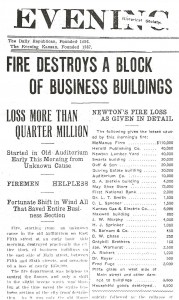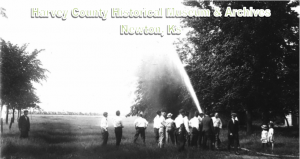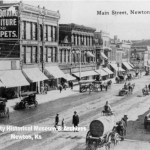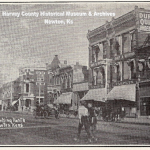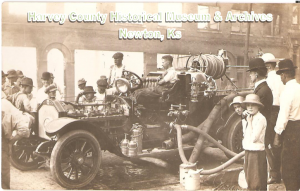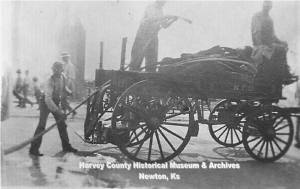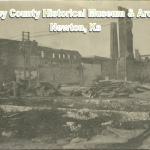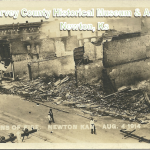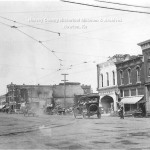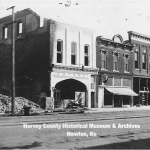by Kristine Schmucker, HCHM Curator
“At last the weary watchers see the spiteful tongues of flames sink lower and lower and the fire is conquered. But where is the most populous block in Newton? In ruins! Nothing now can be done save rebuild . . .” – Marie Tayer, NHS sophomore and winner of essay contest about the “Newton Fire” published in the Evening Kansan-Republican , October 2, 1914.
On the morning of August 4, 1914, Harvey County residents woke to devastating news that a massive fire was burning “the most populous block” in Newton. By the time the fire was put out the entire east side of the 500 block of Main was in ruins. This disaster changed the face of Newton’s Main Street.
Fire Protection in Newton, Ks: “A good demonstration was given.”
Fire was a very real danger to the Newton community almost from the beginning. Dry, wood buildings tended to burn quickly and fire at the various livery stables was a constant concern. After a November 7, 1872 fire, the Newton Hook and Ladder and Bucket Company was formed. A volunteer fire dept was created in November 1877 with B. McKee as the fire chief. Josiah Foltz became the first “partly” paid fire chief in 1899. In 1910, Israel Richardson became the first fire chief to receive a salary for full time work.
In 1914, the City of Newton purchased an American LaFrance Type 12 triple combination pump, hose and chemical automobile fire engine. It was fueled by gasoline.
To show the power of the new engine the Newton Fire Dept gave a demonstration by the Sand Creek Dam on July 9, 1914. The new engine cost $8,500.00.
The new machine was soon pressed into service.
Newton, Ks Main Street, 500 Block east side pre-1914.
- Postcard of 500 Block, east side, looking south, 1913.
- 500 Block, east side, looking north
August 4, 1914: “Fire Destroys a Block of Business Buildings”
The most devastating fire in Newton’s history started at 2:00 a.m., August 4, 1914 in the City Auditorium at 124-126 E 5th. From there the fire quickly spread to the north and west. Even though the fire fighters were able to get there in minutes, after an hour of trying to gain control, they made the decision to call the Wichita Fire Dept., which arrived on the train at about 5:00 a.m.. A fortunate shift in the wind kept the fire from spreading even further.
This was the first test of the new motorized fire engine purchased in May. The pumper ran continuously for 16 hours, breaking the old record of 8 hours of continuous pumping. At times the heat from the fire was so intense that the paint on the engine blistered.
Despite the hard work of the firemen to fight the fire,
“it was evident that the odds were against them. The wind blew the burning embers about. There was not sufficient hose to play the water on so many places at one time and not enough men to manage the hose. Their work was most fatiguing, but they stuck in it, even through the day. “
The Newton Fire Dept. consisted of Chief O.N. Eberle, driver Ed. C. Warhurst, fireman Israel Richardson and seven volunteers. In addition to the Wichita Fire Dept, members of the Santa Fe Railroad Fire Dept and many volunteers. also helped fight the fire that day.
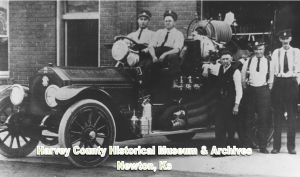
1914 Newton firemen: E.C. Warhurst (Driver); Guy Kemper (Fire Chief); O.N. Eberly (Volunteer Fireman); E.P. Moore & Israel Richardson (Firemen),
“Several Injured During the Fire”
Remarkably, no lives were lost in the fire and very few injuries.
An alert Santa Fe switchman, Patrick Hays, was working “at the Sand Creek switch yard early Tuesday morning, when he noticed flames in town.” Thinking the Santa Fe roundhouse was on fire, he ran to help only to discover flames coming from the Auditorium Hotel on east 5th. Hayes was one of the first ones on the scene and he immediately started helping the firemen. He was even able to hold “the hose direct from the engine for an hour without relief. . . work that usually took four men or at least two.” Hayes fought the fire until he collapsed from fatigue and was taken to Axtell Hospital. It was noted that Hayes had been renting “a room at the Auditorium hotel and had lost all in the fire.”
Another fireman, Aster Early, was “overcome by the heat” and suffered from smoke inhalation. He was taken home and soon recovered. W.C. Moore also received minor injuries.
Aftermath of the Fire: Postcards
The fire destroyed the east side of the 500 block of Main and several businesses located in the 100 block of E. 5th and 6th. Buildings on the west side of Main were damaged, mainly with broken windows and smoke damage. Volunteers set up a brigade and “worked so persistently on the tops of buildings on the west side of Main street.” They were credited with saving the buildings.
Aftermath of Fire: Photographs
- Rt to lt: Grove Grocery, China Emporium, Star Theater. At the north end of the block, facades of the First national Bank and Will May Shoe Store are still standing.
- Lt-Rt: Star Theater, China Emporium, and Crove Grocery.
- Will May’s Shoe Store
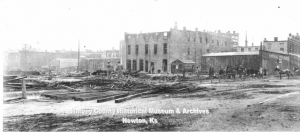
Murphy Studio Photograph looking west to the back of the Main Street Buildings after clean up had begun, August 1914
Sources:
- Kansan, 7 November 1872
- Newton Evening Kansan Republican, 4 August 1914, 5 August 1914, 6 August 1914, 7 August 1914, 17 August 1914, 22 August 1914, 8 September 1914, 14 September 1914, 15 September 1914, 17 September 1914.
- Evening Kansan-Republican , October 2, 1914.
- HCHM Photo Archives
- HCHM Postcard Collection
- Warhurst, Elvin E. “Early Fire Protection in Newton, Kansas: 1872-1922”, 1995 HCHM Archives, Newton, Ks



